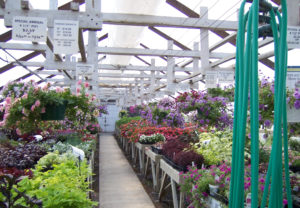Your first line of defense for greenhouse pest control? Keep it clean
Much of using greenhouse sanitation for managing disease, insect and weed pests is common sense. Finding a way to fit it into your production system is sometimes the hard part – making it such a part of how you grow plants that you don’t even have to think about it. As Dr. P. Allen Hammer said in his November ’09 Grower Talks article, sanitation begins with attitude – if clean is encouraged, clean becomes the norm. So, start with the basics and add a few new procedures at a time until they become habit.
Think about what you are trying to control
Large populations of insects, big lesions on plant leaves, or weeds sticking up through the benches are horrifying but easy to spot. But you need to consider the less obvious stages of the pests as well. Disease spores are dust sized, weed seeds can be small, and some insect stages live in places where you can’t easily see them. Most pests also form stages or structures that are meant to survive harsh conditions or long periods of time. Pests can move with soil, with plants, and with pots, or find ways of hiding in structures and equipment.

Keeping hoses up off the floor is one way to reduce disease spread in a greenhouse. Courtesy of Elizabeth Lamb.
Avoid points of contamination
It’s easy to pick up and spread something you can’t see. Hose ends that hit the floor can pick up diseases and spread them to the next pot watered. Tools used in making cuttings or cutting back plants have direct contact with a plant wound so must be dipped in alcohol or a disinfectant frequently. Reused pots, sometimes even ones you have washed, can have disease spores on them ready to infect new plants. Your hands and feet go with you everywhere and you can move virus particles or weed seeds from place to place without ever noticing it.
Clean up as you go
In the busy season, it is easy to feel that you just don’t have time for sanitation. However, in the long run, keeping things clean may save you time in later pest management. Put any crop debris – dropped leaves, trimmings, sick plants – into a covered bin or a bag that can be closed. Cover the container as you carry it out of the greenhouse so insect or disease hitch-hikers don’t jump out. Be meticulous about getting rid of sick or infested plants and scouting around them to make sure what they have hasn’t spread. Assume that anything that hits the floor needs to be tossed or disinfected. Remove weeds in the greenhouse as soon, and as much, as possible. Keep the area outside the greenhouse mowed or mulched 30-35 feet from the house to prevent weeds seeds from coming inside.
Keep your storage area clean
Almost all greenhouses have that area where things get stuck – too big or bulky to store easily, or you don’t need them that often, etc. It’s easy for these areas to be ignored when you are thinking about sanitation. However, dust-carried disease organisms, weed seeds, and flying insects can make it into those spaces, too. If there is light, water and soil, weeds can grow and harbor a population of insects or disease. Cover your pallets of media with a tarp to keep fungus gnats from finding a home through holes in the bags. Make sure pots and flats are stored in their boxes or covered so disease spores don’t contaminate them before you use them. And keep clean pots and media away from used pots and media.
Find time for the bigger jobs
For some sanitation jobs, you really need an empty greenhouse. Disinfecting benches, floors and the greenhouse structure is more efficient and less likely to spread pests if there are no plants in the way. Most chemical weed control products require that no plants are present. Perhaps you can empty one house at a time and clean it, then move plants back in to create another empty house. If you have a down season, do your cleaning earlier than later. It is tempting to wait until it is time to fill the house again – and you definitely deserve a vacation. However, weeds will have produced more seed, diseases and insects may have found weed hosts and spread, and those survival structures that are harder to kill may have formed. Clean your floors first as dust can fly up onto the benches. Consider redoing benches in wire or a non-porous material if you have any wood benches. Fix any drainage issues to prevent puddles from forming. Add, or clean accumulated soil off of, weed fabric on soil or gravel floors to reduce weed problems.
Reading a list of suggested sanitation practices is like looking at a long list of New Year’s resolutions – so daunting that none are accomplished. So choose one practice you haven’t tried yet and see how it fits into your production system. Then add another, and another . . . .


Nice read, I think one of the main things that your article points out that people need to be aware of is doing the “unpleasant” jobs now, to prevent a much larger and more unpleasant job in the future. Keeping pests away from your greenhouse can be a challenge but can also be effectively managed with the right products and the right procedures put in place to ensure that your greenhouse stays in tip top condition throughout all seasons.